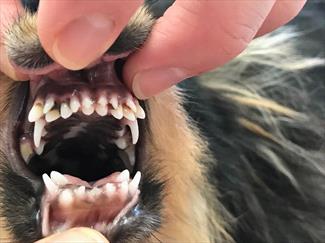Retained Deciduous Teeth, Dog (Photograph)

17 baby teeth were pulled from this 4-pound Pomeranian. Photo by Brittany J. White, DVM
Puppies normally have 28 deciduous (baby) teeth that erupt during the first six months of life, and adults have 42 permanent teeth. Kittens have 26 baby teeth, and adult cats have 30.
In order for the baby teeth to fall out, specific cells resorb (dissolve) the roots of the primary tooth. This allows the permanent teeth to erupt normally. We don't understand what triggers the resorption, so we don't know why some baby teeth don't fall out the way they are supposed to.
When the baby teeth don’t fall out to make way for the permanent teeth, they are called retained deciduous teeth or persistent teeth. They should be extracted soon after they are discovered because otherwise they will cause dental problems (overcrowding in the mouth, plaque buildup, malocclusion, etc.).
As dentists like to say, two teeth should never try to occupy the space intended to contain one tooth.
When both deciduous (persistent) and permanent teeth are trying to occupy the same spot, this double row of teeth overcrowds the mouth, and food gets trapped between the teeth. This trapped food causes periodontal disease. In addition, the double set of roots can prevent the tooth socket from developing normally and eventually erode support around the adult tooth.
These difficulties can be prevented by extracting the retained deciduous teeth as soon as they are seen. If the tooth is extracted early enough, the adult tooth usually will move to its correct position; if it isn't, there is a greater chance that the adult tooth will be in the wrong position, which can cause damage to the tongue, palate, mandible, etc.
It is much easier to position the permanent tooth while it is erupting, not after it has erupted. Repositioning after eruption requires orthodontic care to keep your pet's mouth healthy.